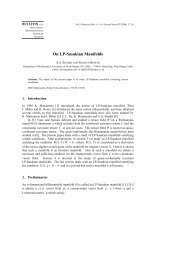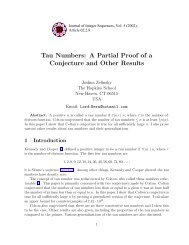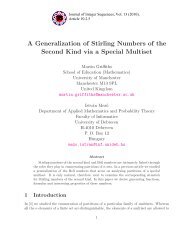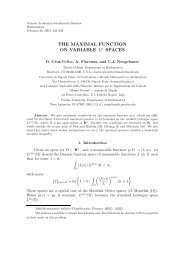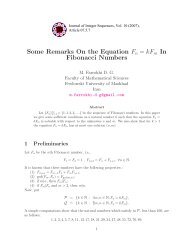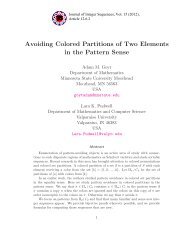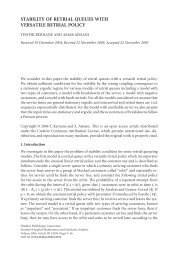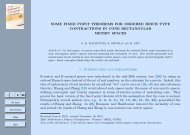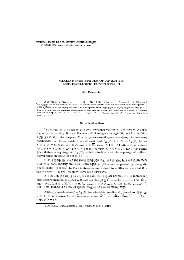- Page 1 and 2: Documenta Mathematica Journal der D
- Page 3 and 4: Documenta Mathematica Extra Volume:
- Page 5 and 6: Richard W. Cottle William Karush an
- Page 7 and 8: Documenta Math. 1 Preface When in d
- Page 9 and 10: Documenta Math. 3 Introduction When
- Page 11 and 12: Introduction 5 Finally, I would lik
- Page 13 and 14: Documenta Math. 7 Stories about the
- Page 15 and 16: Documenta Math. 9 Jiu Zhang Suan Sh
- Page 17: Jiu Zhang Suan Shu and the Gauss Al
- Page 21 and 22: Documenta Math. 15 Leibniz and the
- Page 23 and 24: Leibniz and the Brachistochrone 17
- Page 25 and 26: Documenta Math. 19 Leibniz and the
- Page 27 and 28: Leibniz and the Infinite 21 finally
- Page 29 and 30: Leibniz and the Infinite 23 Because
- Page 31 and 32: Documenta Math. 25 A Short History
- Page 33 and 34: Historical road A Short History of
- Page 35 and 36: A Short History of Newton’s Metho
- Page 37 and 38: Documenta Math. 31 Euler and Infini
- Page 39 and 40: Euler and Infinite Speed 33 Figure
- Page 41 and 42: Euler and Infinite Speed 35 Doctor
- Page 43 and 44: Documenta Math. 37 Euler and Variat
- Page 45 and 46: Euler and Variations 39 Figure 1: L
- Page 47 and 48: Euler and Variations 41 Figure 3: T
- Page 49 and 50: Documenta Math. 43 Euler, Mei-Ko Kw
- Page 51 and 52: Euler, Mei-Ko Kwan, Königsberg, an
- Page 53 and 54: Euler, Mei-Ko Kwan, Königsberg, an
- Page 55 and 56: Euler, Mei-Ko Kwan, Königsberg, an
- Page 57 and 58: Documenta Math. 51 Linear Programmi
- Page 59 and 60: Linear Programming Stories 53 mathe
- Page 61 and 62: Documenta Math. 55 Who Invented the
- Page 63 and 64: Who Invented the Interior-Point Met
- Page 65 and 66: Who Invented the Interior-Point Met
- Page 67 and 68: Who Invented the Interior-Point Met
- Page 69 and 70:
Who Invented the Interior-Point Met
- Page 71 and 72:
Documenta Math. 65 Column Generatio
- Page 73 and 74:
Column Generation for Linear and In
- Page 75 and 76:
Column Generation for Linear and In
- Page 77 and 78:
Column Generation for Linear and In
- Page 79 and 80:
Column Generation for Linear and In
- Page 81 and 82:
Documenta Math. 75 Who Solved the H
- Page 83 and 84:
2 A first counterexample Who Solved
- Page 85 and 86:
Who Solved the Hirsch Conjecture? 7
- Page 87 and 88:
Who Solved the Hirsch Conjecture? 8
- Page 89 and 90:
Who Solved the Hirsch Conjecture? 8
- Page 91 and 92:
Who Solved the Hirsch Conjecture? 8
- Page 93 and 94:
Documenta Math. 87 Pope Gregory, th
- Page 95 and 96:
Pope Gregory, the Calendar, and Con
- Page 97 and 98:
Pope Gregory, the Calendar, and Con
- Page 99 and 100:
Pope Gregory, the Calendar, and Con
- Page 101 and 102:
Documenta Math. 95 Löwner-John Ell
- Page 103 and 104:
2 The ellipsoids Löwner-John Ellip
- Page 105 and 106:
Löwner-John Ellipsoids 99 For maxi
- Page 107 and 108:
H + Löwner-John Ellipsoids 101 t P
- Page 109 and 110:
Löwner-John Ellipsoids 103 any odd
- Page 111 and 112:
Löwner-John Ellipsoids 105 [23] P.
- Page 113 and 114:
Documenta Math. 107 A Brief History
- Page 115 and 116:
A Brief History 109 first-generatio
- Page 117 and 118:
A Brief History 111 developments ar
- Page 119 and 120:
A Brief History 113 in practice. Ka
- Page 121 and 122:
A Brief History 115 that LPs with s
- Page 123 and 124:
Version-to-Version Speedup 10 9 8 7
- Page 125 and 126:
A Brief History 119 [10] Crowder, H
- Page 127 and 128:
A Brief History 121 Robert E. Bixby
- Page 129 and 130:
Documenta Math. 123 Discrete Optimi
- Page 131 and 132:
Discrete Optimization Stories 125 I
- Page 133 and 134:
Documenta Math. 127 The Origins of
- Page 135 and 136:
Minimal Spanning Tree Algorithm 129
- Page 137 and 138:
Minimal Spanning Tree Algorithm 131
- Page 139 and 140:
Minimal Spanning Tree Algorithm 133
- Page 141 and 142:
Minimal Spanning Tree Algorithm 135
- Page 143 and 144:
Minimal Spanning Tree Algorithm 137
- Page 145 and 146:
Minimal Spanning Tree Algorithm 139
- Page 147 and 148:
Minimal Spanning Tree Algorithm 141
- Page 149 and 150:
Documenta Math. 143 The Coming of t
- Page 151 and 152:
The Sixties The Coming of the Matro
- Page 153 and 154:
The Coming of the Matroids 147 Figu
- Page 155 and 156:
The Coming of the Matroids 149 desc
- Page 157 and 158:
The Coming of the Matroids 151 In f
- Page 159 and 160:
The Coming of the Matroids 153 [10]
- Page 161 and 162:
Documenta Math. 155 On the History
- Page 163 and 164:
On the History of the Shortest Path
- Page 165 and 166:
On the History of the Shortest Path
- Page 167 and 168:
On the History of the Shortest Path
- Page 169 and 170:
On the History of the Shortest Path
- Page 171 and 172:
On the History of the Shortest Path
- Page 173 and 174:
On the History of the Shortest Path
- Page 175 and 176:
Documenta Math. 169 On the History
- Page 177 and 178:
Transportation and Maximum Flow Pro
- Page 179 and 180:
Transportation and Maximum Flow Pro
- Page 181 and 182:
Transportation and Maximum Flow Pro
- Page 183 and 184:
Transportation and Maximum Flow Pro
- Page 185 and 186:
Transportation and Maximum Flow Pro
- Page 187 and 188:
Documenta Math. 181 Edmonds, Matchi
- Page 189 and 190:
The Birth of Polyhedral Combinatori
- Page 191 and 192:
The Birth of Polyhedral Combinatori
- Page 193 and 194:
The Birth of Polyhedral Combinatori
- Page 195 and 196:
The Birth of Polyhedral Combinatori
- Page 197 and 198:
The Birth of Polyhedral Combinatori
- Page 199 and 200:
The Birth of Polyhedral Combinatori
- Page 201 and 202:
The Birth of Polyhedral Combinatori
- Page 203 and 204:
The Birth of Polyhedral Combinatori
- Page 205 and 206:
Documenta Math. 199 Flinders Petrie
- Page 207 and 208:
The travelling salesman problem Fli
- Page 209 and 210:
Flinders Petrie 203 accuracy. The r
- Page 211 and 212:
Flinders Petrie 205 Figure 3: Paper
- Page 213 and 214:
Flinders Petrie 207 Figure 4: Petri
- Page 215 and 216:
Flinders Petrie 209 [8] F. R. Hodso
- Page 217 and 218:
Documenta Math. 211 D. Ray Fulkerso
- Page 219 and 220:
D. Ray Fulkerson and Project Schedu
- Page 221 and 222:
D. Ray Fulkerson and Project Schedu
- Page 223 and 224:
G 1 2 D. Ray Fulkerson and Project
- Page 225 and 226:
D. Ray Fulkerson and Project Schedu
- Page 227 and 228:
Documenta Math. 221 The Ongoing Sto
- Page 229 and 230:
The Ongoing Story of Gomory Cuts 22
- Page 231 and 232:
Acknowledgement The Ongoing Story o
- Page 233 and 234:
Documenta Math. 227 Markowitz and M
- Page 235 and 236:
Markowitz and Manne + Eastman + Lan
- Page 237 and 238:
Markowitz and Manne + Eastman + Lan
- Page 239 and 240:
Markowitz and Manne + Eastman + Lan
- Page 241 and 242:
Markowitz and Manne + Eastman + Lan
- Page 243 and 244:
Markowitz and Manne + Eastman + Lan
- Page 245 and 246:
Documenta Math. 239 Ronald Graham:
- Page 247 and 248:
Ronald Graham: Foundations of Onlin
- Page 249 and 250:
Machines Ronald Graham: Foundations
- Page 251 and 252:
Ronald Graham: Foundations of Onlin
- Page 253 and 254:
Documenta Math. 247 Continuous Opti
- Page 255 and 256:
Figure 1: Minkowski’s grave ( c
- Page 257 and 258:
Documenta Math. 251 Cauchy and the
- Page 259 and 260:
Cauchy and the Gradient Method 253
- Page 261 and 262:
Documenta Math. 255 William Karush
- Page 263 and 264:
William Karush and the KKT Theorem
- Page 265 and 266:
William Karush and the KKT Theorem
- Page 267 and 268:
William Karush and the KKT Theorem
- Page 269 and 270:
William Karush and the KKT Theorem
- Page 271 and 272:
William Karush and the KKT Theorem
- Page 273 and 274:
William Karush and the KKT Theorem
- Page 275 and 276:
William Karush and the KKT Theorem
- Page 277 and 278:
Documenta Math. 271 Nelder, Mead, a
- Page 279 and 280:
Nelder, Mead, and the Other Simplex
- Page 281 and 282:
Nelder, Mead, and the Other Simplex
- Page 283 and 284:
Documenta Math. 277 Subgradient Opt
- Page 285 and 286:
Subgradient Optimization in Nonsmoo
- Page 287 and 288:
Subgradient Optimization in Nonsmoo
- Page 289 and 290:
Subgradient Optimization in Nonsmoo
- Page 291 and 292:
Subgradient Optimization in Nonsmoo
- Page 293 and 294:
Subgradient Optimization in Nonsmoo
- Page 295 and 296:
Subgradient Optimization in Nonsmoo
- Page 297 and 298:
Documenta Math. 291 A Science Ficti
- Page 299 and 300:
A Science Fiction Story in Nonsmoot
- Page 301 and 302:
A Science Fiction Story in Nonsmoot
- Page 303 and 304:
A Science Fiction Story in Nonsmoot
- Page 305 and 306:
A Science Fiction Story in Nonsmoot
- Page 307 and 308:
Documenta Math. 301 Broyden Updatin
- Page 309 and 310:
Broyden Updating, the Good and the
- Page 311 and 312:
Broyden Updating, the Good and the
- Page 313 and 314:
Broyden Updating, the Good and the
- Page 315 and 316:
Broyden Updating, the Good and the
- Page 317 and 318:
Broyden Updating, the Good and the
- Page 319 and 320:
Broyden Updating, the Good and the
- Page 321 and 322:
Broyden Updating, the Good and the
- Page 323 and 324:
Documenta Math. 317 Carathéodory o
- Page 325 and 326:
Carathéodory on the Road to the Ma
- Page 327 and 328:
Carathéodory on the Road to the Ma
- Page 329 and 330:
Carathéodory on the Road to the Ma
- Page 331 and 332:
Carathéodory on the Road to the Ma
- Page 333 and 334:
Carathéodory on the Road to the Ma
- Page 335 and 336:
Carathéodory on the Road to the Ma
- Page 337 and 338:
Documenta Math. 331 The Cold War an
- Page 339 and 340:
The Cold War and the Maximum Princi
- Page 341 and 342:
The Cold War and the Maximum Princi
- Page 343 and 344:
The Cold War and the Maximum Princi
- Page 345 and 346:
The Cold War and the Maximum Princi
- Page 347 and 348:
The Cold War and the Maximum Princi
- Page 349 and 350:
The Cold War and the Maximum Princi
- Page 351 and 352:
Documenta Math. 345 The Princess an
- Page 353 and 354:
yB y The Princess and Infinite-Dime
- Page 355 and 356:
x2 The Princess and Infinite-Dimens
- Page 357 and 358:
The Princess and Infinite-Dimension
- Page 359 and 360:
The Princess and Infinite-Dimension
- Page 361 and 362:
The Princess and Infinite-Dimension
- Page 363 and 364:
Documenta Math. 357 Computing Stori
- Page 365 and 366:
Documenta Math. 359 A Brief History
- Page 367 and 368:
A Brief History of NP-Completeness
- Page 369 and 370:
A Brief History of NP-Completeness
- Page 371 and 372:
A Brief History of NP-Completeness
- Page 373 and 374:
A Brief History of NP-Completeness
- Page 375 and 376:
A Brief History of NP-Completeness
- Page 377 and 378:
A Brief History of NP-Completeness
- Page 379 and 380:
A Brief History of NP-Completeness
- Page 381 and 382:
A Brief History of NP-Completeness
- Page 383 and 384:
Documenta Math. 377 On the Evolutio
- Page 385 and 386:
Optimization Modeling Systems 379 T
- Page 387 and 388:
Optimization Modeling Systems 381 m
- Page 389 and 390:
Optimization Modeling Systems 383 C
- Page 391 and 392:
Optimization Modeling Systems 385 a
- Page 393 and 394:
Optimization Modeling Systems 387 e
- Page 395 and 396:
Documenta Math. 389 Who Invented th
- Page 397 and 398:
Who Invented the Reverse Mode of Di
- Page 399 and 400:
Who Invented the Reverse Mode of Di
- Page 401 and 402:
Who Invented the Reverse Mode of Di
- Page 403 and 404:
Who Invented the Reverse Mode of Di
- Page 405 and 406:
Who Invented the Reverse Mode of Di
- Page 407 and 408:
Documenta Math. 401 Gordon Moore an
- Page 409 and 410:
Gordon Moore and His Law 403 Figure
- Page 411 and 412:
Gordon Moore and His Law 405 jector
- Page 413 and 414:
!$ ? !$ > !$ & Gordon Moore and His
- Page 415 and 416:
Gordon Moore and His Law 409 Figure
- Page 417 and 418:
Gordon Moore and His Law 411 Figure
- Page 419 and 420:
� � � � � � � � �
- Page 421 and 422:
Gordon Moore and His Law 415 [14] M
- Page 423 and 424:
Documenta Math. 417 More Optimizati
- Page 425 and 426:
Documenta Math. 419 Voronoi Diagram
- Page 427 and 428:
Voronoi Diagrams and Delaunay Trian
- Page 429 and 430:
Voronoi Diagrams and Delaunay Trian
- Page 431 and 432:
Voronoi Diagrams and Delaunay Trian
- Page 433 and 434:
a a b d Voronoi Diagrams and Delaun
- Page 435 and 436:
Voronoi Diagrams and Delaunay Trian
- Page 437 and 438:
Voronoi Diagrams and Delaunay Trian
- Page 439 and 440:
Documenta Math. 433 Around Hilbert
- Page 441 and 442:
Around Hilbert’s 17th Problem 435
- Page 443 and 444:
Around Hilbert’s 17th Problem 437
- Page 445 and 446:
Documenta Math. 439 From Kepler to
- Page 447 and 448:
From Kepler to Hales 441 Figure 1:
- Page 449 and 450:
From Kepler to Hales 443 assertions
- Page 451 and 452:
From Kepler to Hales 445 |- !A. con
- Page 453 and 454:
Documenta Math. 447 Vilfredo Pareto
- Page 455 and 456:
Vilfredo Pareto and Multi-objective
- Page 457 and 458:
Vilfredo Pareto and Multi-objective
- Page 459 and 460:
Vilfredo Pareto and Multi-objective
- Page 461 and 462:
Documenta Math. 455 Optimisation an
- Page 463 and 464:
Optimisation and Utility Functions
- Page 465 and 466:
Optimisation and Utility Functions



